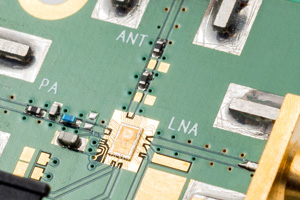- News
27 February 2015
Imec, Murata and Huawei report 0.18μm RF SOI CMOS electrical balance duplexer
At the 2015 GSMA Mobile World Congress (MWC2015) in Barcelona, Spain (2-5 March), Imec, Murata and Huawei are presenting a stand-alone multiband electrical-balance duplexer in 0.18μm RF silicon-on-insulator (SOI) CMOS. This type of duplexer is reckoned to be a promising alternative to the fixed-frequency surface-acoustic wave (SAW) filters implemented in mobile phones providing transmit-to-receive (TX-to-RX) isolation.
SAW duplexers are integrated into existing mobile phones to suppress TX-to-RX signal transfer and avoid unwanted frequency components in the RF signal. As SAW duplexers function at a fixed frequency, more and more SAW duplexers would be needed to enable mobile phones to support the ever-growing number of bands adopted by operators. Due to their frequency-flexibility, electrical-balance duplexers are paving the way to an integrated multi-band solution for TX-to-RX isolation in front-end modules in mobile phones.
 Picture: Electrical-balance duplexer in 0.18μm SOI CMOS.
Picture: Electrical-balance duplexer in 0.18μm SOI CMOS.
Since the new 1.9-2.2GHz duplexer (1.75mm2) is implemented in 0.18μm RF SOI CMOS technology, it enables high-quality integrated passive devices and high-power duplexer operation (+27dBm TX output). It achieves linearity of more than +70dBm IIP3 in both TX and RX, which is comparable to conventional passive SAW filters. This prevents the duplexer from generating nonlinear distortion in the presence of external jammer signals at specific sensitive frequencies and its own large TX signal.
The duplexer achieves low insertion losses, at less than 3.7dB TX and 3.9dB RX, and has isolation characteristics competitive with state-of-the-art SAW duplexers, it is reckoned. It uses a single-ended topology to avoid common-mode leakage issues that could cause the RX to compress for high-power TX input signals. Marking what is claimed to be an industry first achievement - reported at the 2015 IEEE International Solid-State Circuits Conference (ISSCC) in San Francisco (22-26 February) - it is the first electrical-balance duplexer reported to be linear enough to avoid RX de-sensitization due to inter- and cross-modulation between the TX and typical 3GPP-defined jammers.
"Our solution paves the way to integrated reconfigurable multiband front-end modules for frequency-division duplexing in next-generation mobile phones," says Joris Van Driessche, program manager reconfigurable radios at Imec. "Our industrial affiliation program on reconfigurable radios leverages on the multidisciplinary expertise of our global partner network and our own scientific expertise to develop disruptive solutions for today's ever evolving mobile and high-speed wireless communications market," he adds.
The research received funding through the European Union's Seventh Framework Program (EU FP7) project DUPLO (no. 316369).
Imec is presenting its ultra-low-power radios, reconfigurable radios, millimeter-wave communication and sensing, wearable technologies for health, and IC design services at the Flanders Investment & Trade booth (Hall 7, 7G71) at Mobile World Congress 2015.


